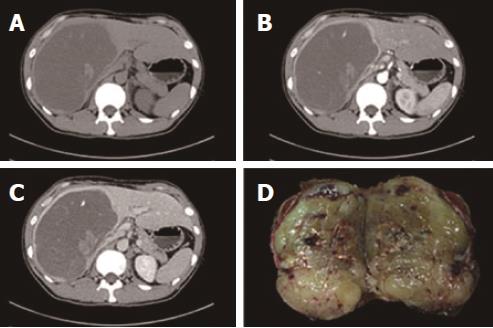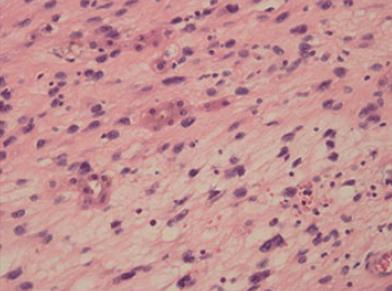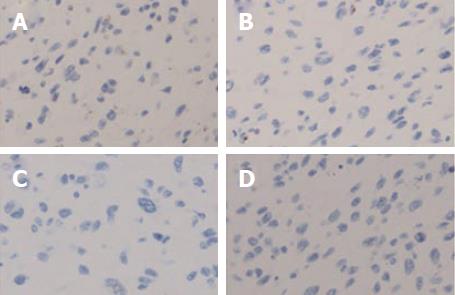Copyright
©The Author(s) 2017.
World J Gastroenterol. Oct 14, 2017; 23(38): 7054-7058
Published online Oct 14, 2017. doi: 10.3748/wjg.v23.i38.7054
Published online Oct 14, 2017. doi: 10.3748/wjg.v23.i38.7054
Figure 1 Computed tomography imaging and surgical specimen.
Dynamic contrast-enhanced computed tomography (CT) imaging showed that a cyst-like lesion (A) contained a stripe-like, slightly hyperdense area and patchy hypodense areas that were hyper-enhanced in the arterial phase (B) and hypo-enhanced in the portal phase (C), whereas the central portion remained unenhanced throughout the arterial and portal phases. Sections through the tumor disclosed grayish-yellow, solid tissue that showed relatively homogenous internal structures (D).
Figure 2 Histological image showing that the tumor cells were spindle shaped and located in a loose myxoid background (hematoxylin-eosin staining; original magnification, × 400).
Figure 3 Histological image showing that the tumor cells contained small- to medium-sized nucleoli with readily identified mitotic figures (hematoxylin-eosin staining; original magnification, × 400).
Figure 4 Immunohistochemical image showing that the tumor tissue was positive for desmin (original magnification, × 400).
Figure 5 Immunohistochemical staining for differential diagnosis.
The tumor tissue was negative for CD31 (A), Factor VIII (B), Melan A (C) and HMB45 (D) (original magnification, × 200).
- Citation: Wen J, Zhao W, Li C, Shen JY, Wen TF. High-grade myofibroblastic sarcoma in the liver: A case report. World J Gastroenterol 2017; 23(38): 7054-7058
- URL: https://www.wjgnet.com/1007-9327/full/v23/i38/7054.htm
- DOI: https://dx.doi.org/10.3748/wjg.v23.i38.7054













